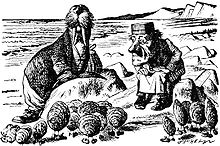The Walrus and the Carpenter

"The Walrus and the Carpenter" is a narrative poem by Lewis Carroll that appears in his book Through the Looking-Glass, published in December 1871. The poem is recited in chapter four, by Tweedledum and Tweedledee to Alice.
Summary
[edit]"The time has come," the Walrus said,
"To talk of many things:
Of shoes—and ships—and sealing-wax—
Of cabbages—and kings—
And why the sea is boiling hot—
And whether pigs have wings."[1]
The poem tells the story of a walrus and a carpenter who meet on a beach and decide to go for a walk. They come across a group of oysters, and the walrus persuades them to come with them. The oysters follow the walrus and the carpenter, and they are eventually all eaten.
Poem
[edit]The sun was shining on the sea Shining with all it's might He did his very best to make The billows smooth and bright And this was odd because it was The middle of the night The Walrus and the Carpenter Were walking close at hand The beach was wide From side to side But much too full of sand Mr. Walrus! Said the Carpenter My brain begins to perk We'll sweep this clear In half a year If you don't mind the work Work?!? The time has come... The Walrus said To talk of many things Of shoes and ships and sealing wax Of cabbages and kings And why the sea is boiling hot And whether pigs have wings Callo-Callay No work today! We're cabbages and kings Oh, uh, Oysters, come and walk with us The day is warm and bright A pleasant walk A pleasant talk Would be a sheer delight Yes, should we get hungry on the way We'll stop and, uh, have a bite Ahem! But Mother Oyster winked her eye And sher heavy head She knew too well this was no time To leave her Oyster bed The sea is nice, Talk my advice And stay right here Mum said Yes, yes of course Of course, but, uh, ha, ha! The time has come My little friends To talk of many things Of shoes and ships and sealing wax Cabbages and kings And why the sea is boiling hot And whether pigs have wings Ha ha Callo-Callay Come, run away With cabbages and kings Well, now, uh, let me see Ah! A loaf of bread Is what we chiefly need! Listen, how 'bout some pepper And salt and vinegar, eh? Well, yes, yes Splendid idea, ha ha! Now, if you're ready Oysters, dear We can begin to feed Feed?!? Oh, yes... The time has come My little friends To talk of food and things Of peppercorns and mustard seeds And other seasonings We'll mix 'em all together In a sauce that's fit for kings Callo-Callay We'll eat today Like cabbages and kings I, uh I, I weep for you I... Oh, excuse me I deeply sympathize For I've enjoyed your company Oh, much more than you realize Little Oysters? Little Oysters? But answer There came none And this was scarcely odd Because They'd been eaten Every one
Interpretations
[edit]The characters of the Walrus and the Carpenter have been interpreted many ways both in literary criticism and popular culture. British essayist J. B. Priestley argued that the figures were political.[2] Walter Russell Mead supposed they represent aspects of Protestant and Transcendentalist societies during Carroll's life.[3] They were also inspired by two sea stacks that stood outside the holiday home Carroll stayed at in Llandudno, Wales.
The 1967 The Beatles song "I Am the Walrus", which is based on the poem, is also a common subject of nonsense inquiry.[4] John Lennon later inferred Carroll's views on capitalism from the poem, joking that perhaps he should have instead sung "I Am the Carpenter".[5]
In the film Dogma, one of the characters claims that the poem is an indictment of organized religion.[6]
Television adaptation
[edit]A series of six episodes starring Hugh Griffith, Felix Aylmer, and Daphne Heard was made by the BBC in 1965.
Film
[edit]The Walrus and the Carpenter story appears in Disney's 1951 animated film Alice in Wonderland where it is told by Tweedledee and Tweedledum.
In the 1999 version of Alice in Wonderland, the story appears near the end of the film, when Alice meets the twins.
See also
[edit]References
[edit]- ^ Carroll, Lewis (1872). Through the Looking Glass : and what Alice found there. London: Macmillan and Co. pp. 75-76.
- ^ Priestley, J. B. (10 August 1957). "The Walrus and the Carpenter". New Statesman. p. 168.
- ^ Mead, Walter Russell (2007). God and Gold. London: Atlantic Books. pp. 43–45. ISBN 978-1-84354-724-2.
As the poem opens, the Walrus and the Carpenter—who, we can suppose, allegorically and respectively represent Britain and the United States—have worked themselves into a typically Protestant and Anglo-Saxon froth of transcendental idealism.
- ^ MacDonald, Ian (2005). Revolution in the Head: The Beatles' Records and the Sixties. Chicago, IL: Chicago Review Press. p. 268. ISBN 978-1-55652-733-3.
- ^ Sheff, David (2000). All We Are Saying: The Last Major Interview with John Lennon and Yoko Ono. New York: St. Martin's Press. p. 185. ISBN 0-312-25464-4.
- ^ "The best earthbound angel scene". The Guardian. 27 December 1999. Retrieved 25 August 2024.
Further reading
[edit]- Gardner, Martin (1999). The Annotated Alice: The Definitive Edition. W. W. Norton & Company. ISBN 0393048470.
External links
[edit] Works related to The Walrus and the Carpenter at Wikisource
Works related to The Walrus and the Carpenter at Wikisource Media related to The Walrus and the Carpenter at Wikimedia Commons
Media related to The Walrus and the Carpenter at Wikimedia Commons The Walrus and the Carpenter public domain audiobook at LibriVox
The Walrus and the Carpenter public domain audiobook at LibriVox
